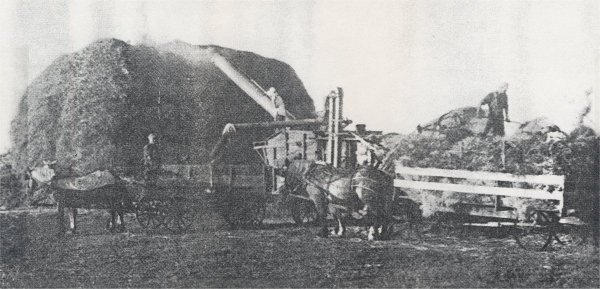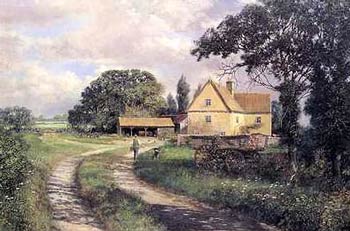![]()
Chapter 11: Togetherness
Back before the roads were paved and even before they were graded and graveled, there was the horse and buggy. We often hitched up Spot to the buggy and visited our friends on a Sunday afternoon. Sunday afternoon get-togethers were a way of life.
Neighbor helping neighbor was also a way of life in those days. Whenever hay was put up, two neighbors would help each other, exchanging work. When there was sickness, hot soup or some other goodies were taken to the sick ones. There were several activities in which people worked together. One was threshing.
Threshing
Threshing was a time neighbors worked together. There were usually about ten farmers who formed a threshing run. They would then hire someone who owned a threshing machine to thresh their oats.
The farmers with small farms generally furnished one man, a hayrack, and a team of horses. Those with larger farms would generally furnish two men, a hayrack, and a wagon with a team of horses. The younger men would fill the hayracks with bundles of oats which had been cut and shocked a few weeks earlier. They then took turns pitching these bundles into the threshing machine, where the oats would be separated from the straw. The oats ended up in a wagon and the straw was blown in another direction onto a huge stack. The older men usually drove the wagons of oats to a granary where it was unloaded.
After the threshing
was done, we had a huge straw stack that was used for feed and bedding for the
animals. It was also possible for a little girl to play and slide down that
straw stack. It was also very big and it was possible to fall and get hurt.
bedding for the
animals. It was also possible for a little girl to play and slide down that
straw stack. It was also very big and it was possible to fall and get hurt.
While the men were threshing, my mother and sisters (and myself, when I was older), would be working inside. Right after breakfast my mother would bake about five pies, which was all our oven would hold. Since apples were ripe, she made nice spicy apple pies. A typical threshers' dinner would be roast beef, potatoes and gravy, green beans, cabbage coleslaw, sliced cucumbers and onions, sliced tomatoes, fresh-baked bread, home-churned butter, and pie.
Drinking water was taken to the men in a large cream can. Quite often we took sandwiches to them in mid-morning. This was not called coffee break, but the mid-morning lunch.
The younger girls
had to help too. They would set up an area where the men could wash for dinner.
They would set a box or old table under a shade tree and place a washtub of
water on it. They would also hang towels and a mirror from the branch of a tree.
Just before the men came in to dinner, mother would get a bushy branch from a
tree. When I was young my job was to stand at the door when the men came in the
house and 'shoo' away the flies.
wash for dinner.
They would set a box or old table under a shade tree and place a washtub of
water on it. They would also hang towels and a mirror from the branch of a tree.
Just before the men came in to dinner, mother would get a bushy branch from a
tree. When I was young my job was to stand at the door when the men came in the
house and 'shoo' away the flies.
The men were generally famished and would eat a large meal. Finally, after they had finished eating, they would go out and rest in the shade of a big tree before going back to work. They did a lot of laughing and joshing at this time. After an hour, it was back to work.
After the men had finished eating, the women would finally relax for the first time all day and eat their own meals. They then had a mountain of dishes to wash. Flies were always a constant problem, and the women might spray the kitchen at this time. In spite of the tree branch being waved, many flies got through. Some people hung a roll of a sticky tape from the ceiling of the kitchen to catch flies, but it wasn't very appetizing having a hundred dead flies hanging over the dinner table.
The first thing every woman asked her husband when he got home from a day's threshing was, "What did you have for dinner?" I think most wives wanted to serve the best meal. Some wives were known for great meals, and some were known for rather skimpy ones.
Hog Butchering
During mid-winter
every farmer butchered hogs for their yearly meat supply. Early in the morning a
neighbor would arrive to help my dad butcher three hogs. A barrel of scalding
water and a table, consisting of a door lying across a couple of sawhorses, had
been set as far away from the house as possible. After a hog was killed and
gutted, it was bathed in the scalding water, and laid out on the table, where it
was skinned and scraped clean. The head was cut off, the carcass was strung up
on a rope, and the organs were removed. My mother was always there to pick up
the liver and heart. She would soak those in cold water and fry them for supper.
sawhorses, had
been set as far away from the house as possible. After a hog was killed and
gutted, it was bathed in the scalding water, and laid out on the table, where it
was skinned and scraped clean. The head was cut off, the carcass was strung up
on a rope, and the organs were removed. My mother was always there to pick up
the liver and heart. She would soak those in cold water and fry them for supper.
The remainder of the carcass was then taken to the corncrib and hung in the alleyway, where it froze solid and was kept for several days to cure. Of course the crib doors had to be shut tight so foxes, raccoons, and other wild animals wouldn't steal it.
After a few days, the carcass was removed to the washhouse where it was cut into parts ready for the kitchen. The fat was trimmed and later rendered into lard. The shoulder meat was cut into small squares and put in glass jars. Mother would then cook these jars in the oven for at least three hours. The hams were rubbed with brown sugar, curing salt, and another substances, which I do not remember. After it was rubbed thoroughly, mother wrapped the ham in brown paper and put it in a cloth bag, where it was hung in a dark room at the back of the washhouse. Mother always fried the pork chops and steak, and put them in crock jars and covered them with lard. If they got a little moldy, you could just scrape off the mold and the meat below was fine. In fact, it was delicious.
The head of the hog was cleaned and cut into small pieces where it was then put in a large pan of water. It was then boiled until the meat could be easily removed. From this we made scrapple. Fried in butter there was no better supper than scrapple on a cold winter's night.
The fat of the hog was stored in a cold place until a warm spring day when we would put it in a large black iron kettle placed in the middle of the barnyard or some other place away from the house. We would start a fire under it and shortly the fat would begin to melt into lard. This lard was used to make pie crusts, fried potatoes, and anything else we fried. The lard was stored in crock jars and kept in the cellar. Most people butchered one hog that was a little fatter than the others. In this way they had plenty of lard to last out the year.
After the lard was drained off, all that remained were the cracklings. They were delicious to eat. Rather fattening, or actually very fattening, but delicious. I loved warm cracklings. On another warm day, water and lye were added to the remaining cracklings and another fire was built. Upon heating this mixture turned into a thick, goody soup, which was poured out on a flat surface to cool and harden. After it hardened, it was cut into large bars. The result was the strongest soap you've ever seen in your life. This lye soap was used to wash our clothes.
There is a lot of truth to the old saying, "Everything except the squeal was used when you butchered a hog."
Radio Days
When the radio
first came out, we never had one but one of our neighbors did. We, along with
other friends and neighbors, would go to their house and everyone would gather
around the radio to listen to special programs. More often than not, the static
was so bad that nothing could be heard. It was still a lot of fun trying to
catch every third word.
along with
other friends and neighbors, would go to their house and everyone would gather
around the radio to listen to special programs. More often than not, the static
was so bad that nothing could be heard. It was still a lot of fun trying to
catch every third word.
Every radio needed am antenna. After we bought our first radio we ran a wire from the house to the top of the windmill. This made for good reception most of the time. One night lightening struck the windmill, and it sure woke us up. Our farm didn't have electricity so the radio ran on batteries. A large battery, similar to a car battery, was placed on the floor near the radio.
When someone died, neighbors would bring food to the bereaved family. The funeral director, or undertaker, as they were called then, came to the home and prepared the body. Several men in the neighborhood would stay with the body all night so the family could get some rest. They did this until the funeral ceremony. I remember my first funeral. The funeral car, or hearse, was white. I thought it looked like a ghost. I did not like its appearance and was glad its style was changed so it looked more like any other car.
![]()
Continue to Chapter 12: The Great Depression